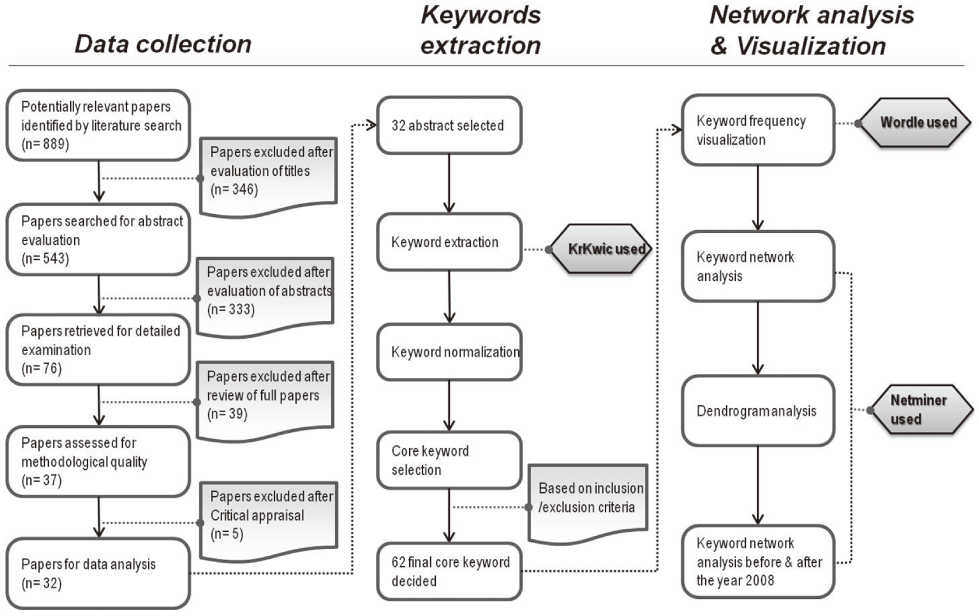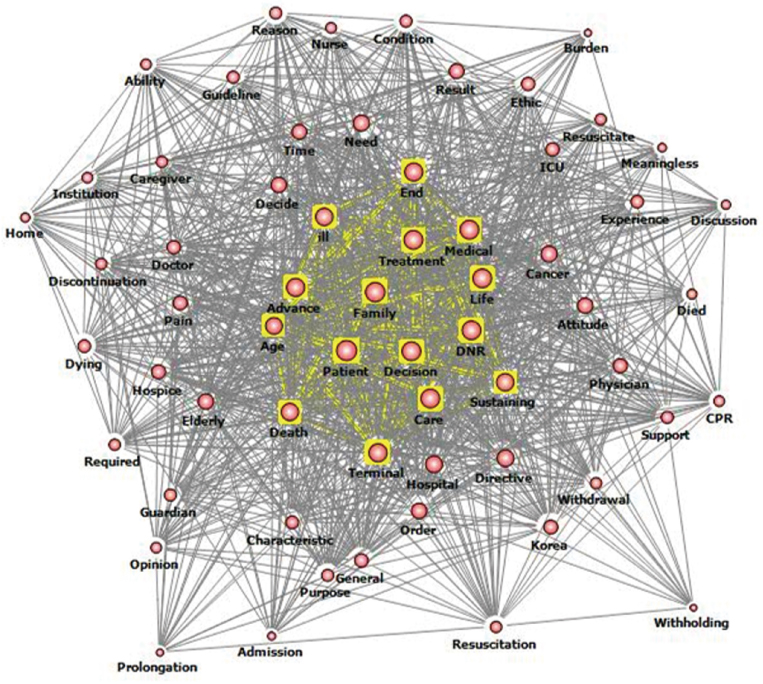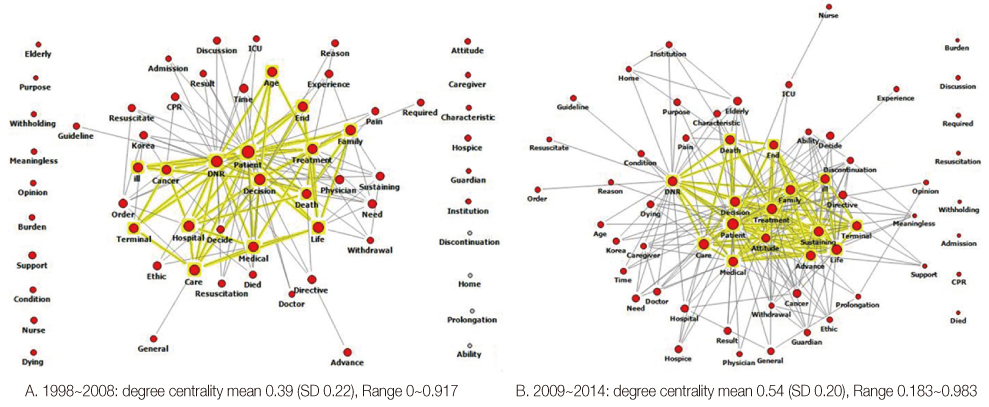Asian Oncol Nurs.
2014 Dec;14(4):254-264. 10.5388/aon.2014.14.4.254.
Research Trend Analysis of Do-Not-Resuscitate Decision: Based on Text Network Analysis
- Affiliations
-
- 1Graduate School of Nursing, Chung-Ang University, Seoul, Korea. SMNOH@cau.ac.kr
- 2Department of Nursing, Chung-Ang University, Seoul, Korea.
- 3Graduate School of Information, Yonsei University, Seoul, Korea.
- KMID: 2269448
- DOI: http://doi.org/10.5388/aon.2014.14.4.254
Abstract
- PURPOSE
The purpose of this study was to identify a research trend of studies related to the Do-Not-Resuscitate (DNR) decision making process in Korea.
METHODS
Assessing through five computerized databases, 889 studies were reviewed and of these 32 were included. An integrative literature review and text network analysis were applied to examine the research. The keywords from each article's abstracts were extracted by using a program, KrKwic.
RESULTS
The number of studies on DNR decision has been increasing, especially since 2011. A descriptive study design (59%) was most commonly used in the research. In relation to factors affecting DNR decision, 97% of the studies stated patient factors and 66% stated family factors. 'Patient', 'DNR', 'decision', 'treatment', 'life', 'family' were the major keywords, and 'patient' and 'care' were dominant keywords that ranked high in coappearance frequency.
CONCLUSION
Studies related to DNR decision have been increasing, and themes of the studies have also been broader. Further research is required to investigate factors affecting DNR decision in specific populations such as cancer patients, the elderly, patients with end-stage of chronic diseases etc. Moreover, a comparative study is necessary to define differences of research trends related to DNR decision making process between Korea and other countries.
Keyword
Figure
Cited by 3 articles
-
Comparison of Life-Sustaining Treatment in Terminal Cancer Patients between a Cancer and Hospice Unit after Do-Not-Resuscitate Orders
Eun Jeong Nam, Se-Na Lee, Ran Lee
Asian Oncol Nurs. 2018;18(4):198-205. doi: 10.5388/aon.2018.18.4.198.Using Text Network Analysis for Analyzing Academic Papers in Nursing
Chan Sook Park
Perspect Nurs Sci. 2019;16(1):12-24. doi: 10.16952/pns.2019.16.1.12.Text Network Analysis Related to Disclosure of Cancer Diagnosis among Korea and other Countries
Jin Hui Yun, Eunjung Ryu, So Young Lee
Asian Oncol Nurs. 2018;18(3):154-162. doi: 10.5388/aon.2018.18.3.154.
Reference
-
1. Kim SH. Decision making process in Do-Not-Resuscitate orders for patients with cancer. Korean J Nurs Query. 2005; 13(1):127–143.2. Lee SB, Lee WS. A study on a patient's self-determination right and advance directive in withdrawal of life sustaining treatment. Korean Criminol Rev. 2010; 2010(30):1–158.3. Lee K, Jang HJ, Hong SB, Lim CM, Koh YS. Do-not-resuscitate order in patients, Who were deceased in a medical intensive care unit of an university hospital in Korea. Korean J Crit Care Med. 2008; 23(2):84–89.
Article4. Chang CY, Kim YS. Attitude toward forgoing life-sustaining treatment among cancer patient families. Ment Health Soc Work. 2011; 38:5–30.5. Song T, Kim KP, Koh YS. Factors determining the establishment of DNR orders in oncologic patients at a university hospital in Korea. Korean J Med. 2008; 74(4):403–410.6. Kim MH, Kang EH, Kim MY. Family decision-making to withdraw life-sustaining treatment for terminally-ill patients in an unconscious state. Korean J Hosp Palliat Care. 2012; 15(3):147–154.
Article7. Kwon YC, Shin DW, Lee JH, Heo DS, Hong YS, Kim SY, et al. Impact of perception of socioeconomic burden on advocacy for patient autonomy in end-of-life decision making: a study of social attitude. Palliat Med. 2009; 23(1):87–94.
Article8. Shim BY, Hong SI, Park JM, Cho HJ, Ok JS, Kim SY, et al. DNR (Do-Not-Resuscitate) Ordr for terminal cancer patients at hospice ward. Korean J Hosp Palliat Care. 2004; 7(2):232–237.9. Park YO. Withdrawing of life-sustaining trearment. Paju: Korean Studies Information;2008.10. Sun DS, Chun YJ, Lee JH, Gil SH, Shim BY, Lee OK, et al. Recognition of advance directives by advanced cancer patients and medical doctors in hospice care ward. Korean J Hosp Palliat Care. 2009; 12(1):20–26.
Article11. Choi YC, Park SJ. A study on the research trend of Korean public administration: application of network text analysis. Korean Public Adm Rev. 2011; 45(1):123–139.12. Park HW, Leydesdorff L. Understanding the KrKwic: a computer program for the analysis of Korean text. J Korean Data Anal Soc. 2004; 6(5):1377–1387.13. Park CS, Jung JW. Text network analysis: sharing meanings among stakeholders of the policy through a socio-cognitive network analysis. J Gov Stud. 2013; 19(2):75–110.14. Rivadeneira AW, Gruen DM, Muller MJ, Millen DR. Getting our head in the clouds: toward evaluation studies of tagclouds. In : Proceedings of the CHI 2007; California, USA. New York: ACM;2007. p. 995–998.15. Ryu SI, Lee MK, Jung SH, Kang HG. The trends of crisis emergency management research in korea. Korean Rev Crisis Emerg Manage. 2012; 8(3):105–120.16. Kwon I, Koh YS, Yun YH, Heo DS, Seo SY, Kim HC, et al. A study of the attitudes of patients, family members, and physicians toward the withdrawal of medical treatment for terminal patients in Korea. Korean J Med Ethics. 2010; 13(1):1–16.
Article17. Kim ES. The attitude of the terminally ill cancer patients, the families and medical teams for discontinuation of meaningless life-sustaining treatment and self decision-making [dissertation]. Daejeon: Chungnam National Univ.;2011.18. Lee SR, Shin DS, Choi YJ. Perceptions of caregivers and medical staff toward DNR and AD. Korean J Hosp Palliat Care. 2014; 17(2):66–74.
Article19. Lee JY, Choi EH, Park KS. Awareness and ethical attitudes toward ‘Do-Not-Resuscitate (DNR)'for cancer patients. Asian Oncol Nurs. 2014; 14(1):32–40.
Article20. OK JH, YI MS. Understanding the experiences of family members who make Do-Not-Resuscitate decisions for cancer patients. Korean J Med Ethics. 2012; 15(1):34–51.
Article21. Lee HK, Kang HS. Attitudes and awareness towards the withdrawal of life-sustaining treatment among nurses, physicians, and families of intensive care unit patients. J Korean Clin Nurs Res. 2010; 16(3):85–98.22. Jung YR. A study of difference in perception of 'Do Not Resuscitate' between medical doctors and relative caregivers for the patient with a advanced disease [dissertation]. Daegu: School of Public Health Daegu Haany Univ.;2014.23. An AR. Late discussion about end-of-life care in terminal cancer patients: a retrospective cohort study. Seoul: Seoul National Univ.;2012.24. Lee YJ, Lee HS. An integrative review of Do-Not-Resuscitate Decisions: focused on Korean data after 2010. J Korean Bioethics Assoc. 2013; 14(2):41–52.25. Heo DS. Patient autonomy and advance directives in Korea. J Korean Med Assoc. 2009; 52(9):865–870.
Article26. Oh DY, Kim JH, Kim DW, Im SA, Kim TY, Heo DS, et al. CPR or DNR? end-of-life decision in korean cancer patients: a single center's experience. Support Care Cancer. 2005; 14(2):103–108.
Article27. Lee IY. A study on the legal analysis and public opinion survey on euthanasia. J Crim Law. 2008; 20(2):167–200.
Article
- Full Text Links
- Actions
-
Cited
- CITED
-
- Close
- Share
- Similar articles
-
- Using Text Network Analysis for Analyzing Academic Papers in Nursing
- Analysis of Students Experience related of Nursing Management Clinical Practice: Text Network Analysis Method
- Research trends in the Korean Journal of Women Health Nursing from 2011 to 2021: a quantitative content analysis
- Research Trend on Diabetes Mobile Applications: Text Network Analysis and Topic Modeling
- A Study on Research Trend for Nurses' Workplace Bullying in Korea: Focusing on Semantic Network Analysis and Topic Modeling






